Telangana TSBIE TS Inter 1st Year Botany Study Material 5th Lesson Morphology of Flowering Plants Textbook Questions and Answers.
TS Inter 1st Year Botany Study Material 5th Lesson Biological Classification
Very Short Answer Type Questions
Question 1.
Differentiate fibrous roots from adventitious roots. [Mar. – 2020]
Answer:
1) Adventitious roots :
The roots that arise from plant parts other than radicle.
Ex: Climbing roots, Velamen roots, Respiratory roots etc.
2) Fibrous roots :
Large number of roots which originate from the base of the stem after the loss of short lived primary root. Ex: Monocot plants.
Question 2.
Define modification. Mention how root is modified in banyan tree and mangrove plants ?
Answer:
1) Modification :
A permanent morphological change in a plant organ to perform a special function depending upon environment.
2) In banyan tree, roots are modified as prop roots (pillar roots) to give additional support for branches.
While in mangrove plants (Rhizophora and Avicennia) pneumatophores or respiratory roots come out of the ground and grow vertically upwards to get oxygen for respiration.
Question 3.
What type of specialized roots are found in epiphytic plants ? What is their function ?
Answer:
1. Velamen roots are found in epiphytic plants like Vanda.
2. They absorb moisture from the atmosphere.
Question 4.
How does the sucker of Chrysanthemum differ from the stolon of jasmine?
Answer:
- Sucker of Chrysanthemum is the lateral branch arises from the basal and underground portion of stem. It grows obliquely upward giving rise to leafy shoot.
- Stolon of jasmine is an obliquely downward growing slender lateral branch that arises from the base of the main axis and produces adventitious roots on touching the ground.
![]()
Question 5.
What is meant by pulvinus leaf base? In members of which Angiospermic family do you find them? [Mar. ’14 – A.P. ; Mar. ’14]
Answer:
- The swollen leaf base is called pulvinus leaf base.
- It is found in some members of leguminaceae family.
Question 6.
Define venation. How do dicots differ from monocots with respect to venation? [Mar. ’15 – A.P.]
Answer:
- The arrangement of veins and the veinlets in the lamina of leaf is termed as venation.
- Leaves of dicots have reticulate venation, whereas, leaves of monocots possess parallel venation.
Question 7.
How is a pinnately compound leaf is different from a palmately compound leaf? Explain with one example, each.
Answer:
- Pinnately compound leaf: It consists of a number of leaflets on a common axis called rachis. Ex: Neem.
- Palmately compound leaf: If consists of leaflets attached at a common point, i.e., at the tip of the petiole. Ex: Bombax ceiba (silk cotton).
Question 8.
Which organ is modified to trap insects in insectivorous plants? Give two examples. [Mar. 2019, ’13]
Answer:
- Leaves are modified to trap insects in insectivorous plants.
- Example : Nepenthes (Pitcher plant), Dionea (Venus fly-trap).
Question 9.
Differentiate between Racemose and Cymose inflorescences. [Mar. ’15 – T.S.]
Answer:
- Racemose inflorescence: The main axis (Peduncle) continues to grow and produce flowers in an acropetal succession.
- Cymose inflorescence: The main axis ends in a flower due to limited growth and flowers are borne in basipetal succession.
Question 10.
What is the morphology of cup like structure in Cyathium? In which family it is found? [Mar. – 2018, Mar. ’15 – A.P.]
Answer:
- In Cyathium, involucre of bracts form cup like structure.
- It is found in family Euphorbiaceae.
Question 11.
What type of inflorescence is found in fig trees ? Why does the insect B/astophaga visits the inflorescence of fig tree?
Answer:
- Hypanthodium is found in fig trees.
- The insect Blastophaga visits for pollination and lays its eggs in the gall flowers.
Question 12.
Differentiate actinomorphic from zygomorphic flower. [May ’14]
Answer:
1. Actinomorphic flower :
A flower that can be divided into two equal radial halves in any radial plane passing through the centre Ex: Hibiscus.’
2. Zygomorphic flower :
A flower that can be divided into two similar halves only in one particular vertical plane Ex: Bean.
Question 13.
How do the petals in pea plant are arranged? What is such type of arrangement called?
Answer:
- In pea plant there are five petals. The largest (standard) petal overlaps the two lateral (wings) petals that inturn overlap the two smallest anterior petals (keel).
- This arrangement is called vexillary or papilionaceous.
![]()
Question 14.
What is meant by Epipetalous condition ? Give an example. [May ’17, Mar. ’17 – A.P.]
Answer:
- Epipetalous condition : A condition in which stamens attached to the petals.
- Ex: Brinjal, Datura.
Question 15.
Differentiate between apocarpous and syncarpous ovary. [Mar. – 2018]
Answer:
1) Apocarpous ovary :
More than one carpel is present in gynoecium and they are free. Eg : Lotus and Rose
2) Syncarpous condition :
Carpels are fused. Eg: Mustard and Tomato.
Question 16.
Define placentation. What type of placentation is found in Dianthus? [Mar. – 2020, Mar. 15 – T.S.]
Answer:
- The arrangement of ovules within the ovary is known as placentation.
- In Dianthus, free central placentation is present.
Question 17.
What is meant by parthenocarpic fruit? How is it useful?
Answer:
- A fruit formed without fertilization of the ovary is called parthenocarpic fruit.
- They are without seeds. Ex: Banana.
Question 18.
What is the type of fruit found in mango? How does it differ from that of coconut?
Answer:
- The type of fruit found in mango is drupe. In which the pericarp is well differentiated into an outer thin epicarp, a middle fleshy edible mesocarp and an inner stony hard endocarp.
- In coconut, also fruit is a drupe in which the mesocarp is fibrous.
Question 19.
Why certain fruits are called false fruits ? Name two examples of plants having false fruits.
Answer:
- Certain fruits that develop from floral parts other than the ovary called false fruits.
- Ex: Apple (Thalamus) Cashew (Pedicel) Strawberry (Thalamus.)
Question 20.
Name any two plants having single seeded dry fruits.
Answer:
- Dry indehiscent fruits are single seeded.
- Coryza (caryopsis) and Tridax (Cypsela).
Question 21.
Define schizocarpic dry fruits. Give an example.
Answer:
- The dry fruits which split into one Seeded bits called mericarps are known as Schizocarpic dry fruits.
- Ex: Acacia, Castor.
Question 22.
Define mericarp. In which plant you find it?
Answer:
- One seeded bits formed after splitting of Schizocarpic dry fruits are called mericarp.
- Ex: Acacia, Castor.
Question 23.
What are aggregate fruits? Give two examples.
Answer:
- Bunch of fruitlets developed from multicarpellary, apocarpous ovary are called aggregate fruits.
- Ex: Custard apple (Annona squamosa), Strawberry.
![]()
Question 24.
Name a plant that has single fruit developing from the entire inflorescence. What is such a fruit called?
Answer:
Single fruit that develops from an entire inflorescence is called composite fruit. Ex: Pineapple, Jack fruit.
Short Answer Type Questions
Question 1.
Explain different regions of root with neat labeled diagram.
Answer:
Root has four regions. They are
a) Root cap
b) Region of rheristematic activity
c) Region of elongation
d) Region of maturation.
a) Root cap :
The tip of the root is covered by a thimble-like structure called the root cap. It gives protection to the root tip as it penetrates into the soil.
b) Region of meristematic activity :
Above the root cap, region of meristematic activity is present. It has meristematic cells. These cells are small, thin walled with dense protoplasm. They divide repeatedly.
c) Region of elongation :
Above the region of meristematic activity, region of elongation is present. The new cells formed grows and elongates. It is responsible for growth of length.
d) Region of maturation :
Behind the region of elongation region of maturation is present. Depending upon the function young cells differentiates into permanent cells. As it matures, it is called region of maturation.
From this region, some of the epidermal cells forms unicellular root hairs. The main function of root hairs is absorption of water from the soil. They are short lived.
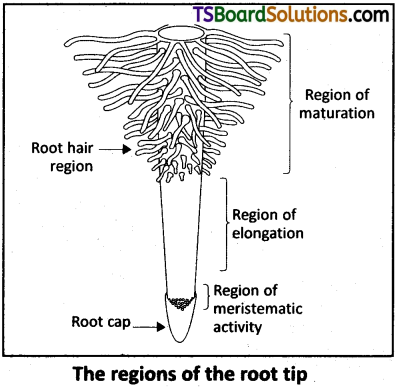
Question 2.
Justify the statement: “Underground parts of plants are not always roots”.
Answer:
Normally roots are underground whereas stems are aerial. But in some plants stem grow below the soil. They are called underground stems. They are rhizome corm, stem tuber and bulb.
These underground parts of the plants can be recognised as stem due to presence of nodes, internodes, scale leaves, axillary buds and terminal buds. They can be even identified by their anatomical structures.
For example, stem tubers (Potato), these are underground branches which store food at the tip and becomes tuberous. The tuber is covered by brown coloured layer. It bears many ‘eye’ like structures. These eyes represent the nodes. Each eye has leaf scar and axillary bud. Scar represents the position of scale leaf. Eye help in vegetative propagation.
![]()
Question 3.
Explain with examples different types of phyllotaxy.
Answer:
The mode of arrangement of leaves on the stem and branches is called phyllotaxy. It is three types. They are
a) Alternate phyllotaxy :
In this type only one leaf arises at each node in alternate manner.
Eg : Hibiscus, rosa-sinensis (china rose), mustard, sunflower.
b) Opposite phyllotaxy :
In this type, a pair of leaves arise at each node and lie opposite to each other. Eg : Calotropis, Guava.
c) Whorl phyllotaxy :
In this type, more than two leaves arise at a node and form a whorl. Eg : Nerium, Alstonia.
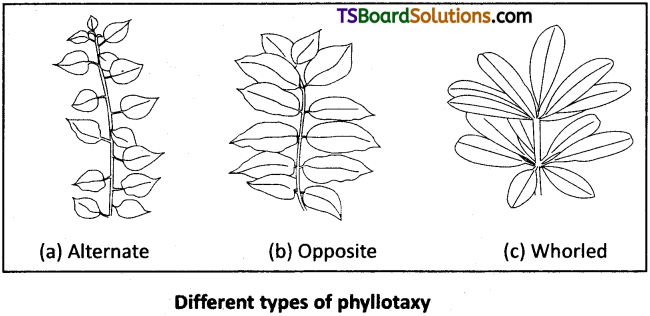
Question 4.
How do leaf modifications help plants?
Answer:
The main function of leaf is photosynthesis and transpiration. In some plants leaves change in their structure to perform new function other than photosynthesis. This is called leaf modification.
1. Tendrils :
In weak stemmed plant, the entire leaf or any part of the leaf is modified into tendrils. They provide mechanical support and help in climbing. Eg: Pea.
2. Spine :
In some plants, leaves are modified into sharp pointed spines. They help in reducing the rate of transpiration in xerophytic plants and also for defence.
Eg: Cacti.
3. Storage leaves :
The fleshy leaves of onion and garlic store food materials.
4. Phyllode :
In some plants such as Australian acacia, the leaves are pinnately compound in which the leaflets are small and short lived. The petioles of these plants expand into green structure performing photosynthesis. These are called phyllode.
5. Insectivorous leaves :
In plants growing in nitrogen deficient soils, leaves are modified to trap insects for their nitrogen requirement.
Eg : Nepenthes (Pitcher plant)
Dionea (Venus fly trap)
6. Vegetative propagation :
In some plants leaves produce buds called epiphyllous buds. They help in vegetative propagation. Eg : Bryophyllum.
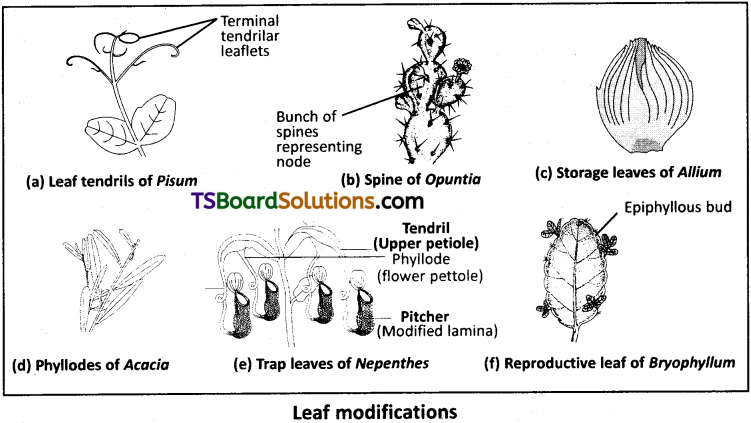
Question 5.
Describe any two special types of inflorescences.
Answer:
(Note : Write any two of the following 🙂
Verticellaster, Cyathium and Hypanthodium are special types of inflorescence.
Verticellaster:
- It is a special type of inflorescence found in the family Lamiaceae (Labiatae).
- In this type, flowers arise in the axil of leaves arranged opposite to each other at every node.
- In the axil of leaf, the flowers are developed initially in dichasial cyme and later in monochasial scorpoid cyme.
- Flowers are crowded round the node like a false whorl (verticel). Hence it is called ‘Verticellaster’.
Eg: Leucas and Leonotis.
Cyathium :
- This is a single flower like special inflorescence found in family Euphorbiaceae.
- The inflorescence is covered by a deep cup like involucre of bracts.
- At the centre of this cup there is a single female flower represented by tricarpellary syncarpous ovary.
- Surrounding this female flower many male flowers are arranged in monochasial cyme.
- Male flowers are represented by single stalked stamen. Male and female flowers are achlamydeous arranged in centrifugal manner. Eg: Euphorbia, Poinsettia.
Hypanthodium :
- It is fruit like inflorescence.
- In this peduncle is modified into a deep cup like fleshy structure with an apical opening.
- The male flowers located near the opening and the female flowers are at the bottom while in between them the sterile female flowers called gall flowers are present.
- Pollination in these plants takes place by an insect called Blastophaga which lay its eggs in the gall flowers. After fertilisation the whole inflorescence becomes into a fig fruit.
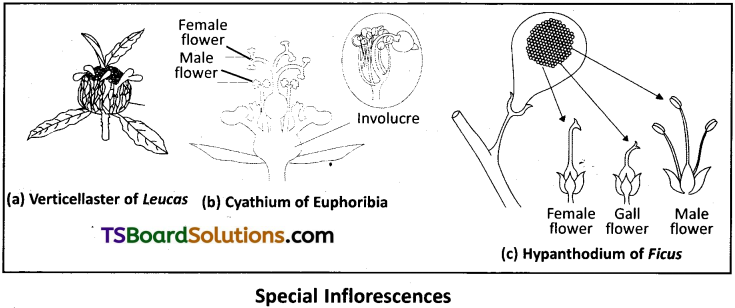
Question 6.
Describe the arrangement of floral members in relation to their insertion on thalamus.
Answer:
Depending upon the arrangement of floral members in relation to their insertion on thalamus, flowers are divided into three types. They are
1) Hypogynous :
Thalamus is conical. The gynoecium occupies the highest position. The remaining floral members like calyx, corolla and androecium are at the base of the gynoecium. In this the ovary is called “Superior”.
Ex : Hibiscus, Datura, Mustard, Brinjal etc.
2) Perigynous :
Thalamus is concave or saucer shaped. Gynoecium is situated at the centre. The remaining floral members like calyx, corolla and androecium are arranged along the margin, almost at the same level. In this, the ovary is said to be half inferior or half superior. Ex: Tephrosia, plum, rose, peach etc.
3) Epigynous flower :
In this, thalamus is deep cup like structure, inside it gynoecium is present. The walls of the thalamus and ovary are fused. The remaining floral members are arranged along the margins of the thalamus, i.e. above the level of ovary. So, the ovary is called inferior. Ex : Tridax, guava, cucumber, ray floret of sunflower.
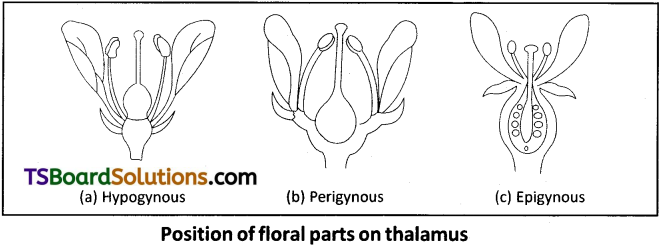
Question 7.
“The flowers of many angiospermic plants which show sepals and petals, differ with respect to the arrangement of sepals and petals in respective whorls’. Explain.
Answer:
The arrangement of sepals and petals in floral bud is known as aestivation. It is of different types.
1) Valvate aestivation :
When sepals or petals in a whorl just touch one another at the margin without overlapping is called valvate aestivation. Eg : Calotropis.
2) Twisted aestivation :
When sepals or petals margin in a whorl overlap one another it is said to be twisted aestivation. Eg: Corolla of hibiscus, cotton, lady’s finger etc.
3) Imbricate aestivation :
If the margins of sepals or petals overlap one another but not in any particular direction is called imbricate aestivation. Eg : Cassia, gulmohur.
4) Vexillary or Papilionaceous aestivation :
In this, there are five petals. The largest petal towards posterior side is called Vexillum or Standard Petal. It overlaps the two lateral petals called Alae or wing petal. These overlap the two smallest petals called keel petals towards anterior side, which are boat shaped. Ex : Bean, Pea.
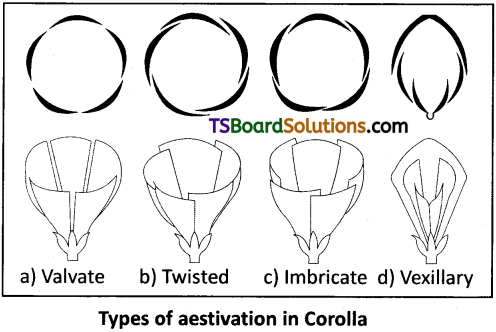
Question 8.
Describe any four types of placentations found in flowering plants.
Answer:
The arrangement of ovules within the ovary is known as placentation. They are Marginal placentation: Placenta forms a ridge along the ventral suture of the ovary. Ovules are borne on this ridge forming two rows. Eg: Pea
Axial placentation :
When the placenta is axial and ovules are attached to it in multilocular ovary, it is called axile placentation. Eg: China rose, rose, tomato and lemon.
Parietal placentation :
Ovules born on the inner wall of the ovary or on a parietal part, it is called parietal placentation. Ovary is one chambered but it becomes two chambered due to the formation of the false septum. Eg: Mustard and Argemone. Free central placentation : When the ovules are borne on the central axis without septa, it is known as free central placentation. Eg : Dianthus, primrose.
Basal placentation :
Single ovule is attached to placenta at the base of the ovary. It is called Basal placentation. Eg : Sunflower, marigold.
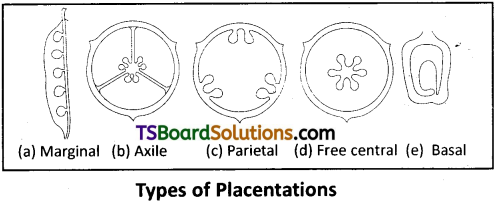
Question 9.
Describe in brief fleshy fruits by you studied.
Answer:
In fruits where pericarp becomes fleshy at the time of ripening are called fleshy fruits. Pericarp can be divided into three layers namely outer epicarp, middle mesocarp and inner endocarp. Basing upon the nature of pericarp, fleshy fruits are divided into five types. They are
1) Drupe :
It is one seeded fleshy fruit developed from monocarpellary, superior ovary. The fruit is characterised by stony endocarp. So it is known as Drupe.
In Mango, the outer epicarp is thin, middle mesocarp is fleshy and edible. The inner endocarp is hard stony.
In coconut, the outer epicarp is thin, middle mesocarp is fibrous and inner endocarp is hard stony. The edible part is the endosperm of seed (Copra).
2) Berry :
It is a fleshy fruit having one or more seeds. In this, epicarp is thin. Mesocarp and endocarp are fused to form pulp. Seeds are hard. These fruits develop from bi to multicarpellary syncarpous gynoecium: Eg : Guava, grapes, tomato.
3) Pome :
It is a fleshy fruit developed from inferior ovary of bi or multicarpellary syncarpous gynoecium. It is surrounded by fleshy thalamus. The endocarp is cartilagenous. Eg: Apple.
4) Pepo :
It is developed from tricarpellary syncarpous unilocular inferior ovary. The epicarp is like a rind., the mesocarp is fleshy and the endocarp is smooth. Eg : Cucumber.
5) Hesperidium :
It is developed from multicarpellary syncarpous, multilocular and superior ovary. In this epicarp is leathery with many volatile oil glands. Mesocarp is papery and endocarp has many chambers filled with juicy hairs. Eg : Citrus.
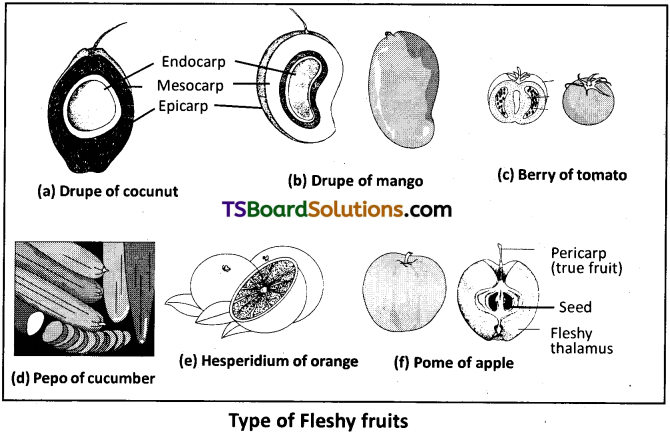
Question 10.
Describe with examples the various dry fruits studied by you.
Answer:
When the fruit wall or pericarp is dry or non-fleshy they are called dry fruits. They are of three types (i) Dry dehiscent (ii) Dry indehiscent (iii) Schizocarpic.
i) Dry dehiscent :
The dry fruit which break open and liberate the seeds are called dry dehiscent fruits. They are of different types.
a) Legume :
The fruits which break dorsiventrally into two halves liberating the seeds are called legumes. It is a characteristic fruit of family fabaceae. Eg : Pea, bean etc.
b) Capsule :
It is a dry fruit which liberates seeds in different ways at maturity. Eg : Cotton, Datura.
ii) Dry indehiscent fruits :
These dry fruits are normally one seeded and never dehisce even at maturity. The seeds are liberated only after the disintegration of the pericarp. They are of following types.
1) Caryopsis :
In this the pericarp and seed coat fuse together. It is a characteristic, . fruit of family poaceae. Ex: Grass, Rice.
2) Nut :
This single seeded dry fruit has a stony pericarp. The pericarp and seed coat remains free. Eg : Cashew.
3) Cypsela :
The single seeded fruit characterized by persistent pappus like calyx. Eg: Tridax.
iii) Schizocarpic fruits :
The fruit which split into one-seeded bits called mericarps are called schizocarpic fruits. Eg: Acacia, Castor.
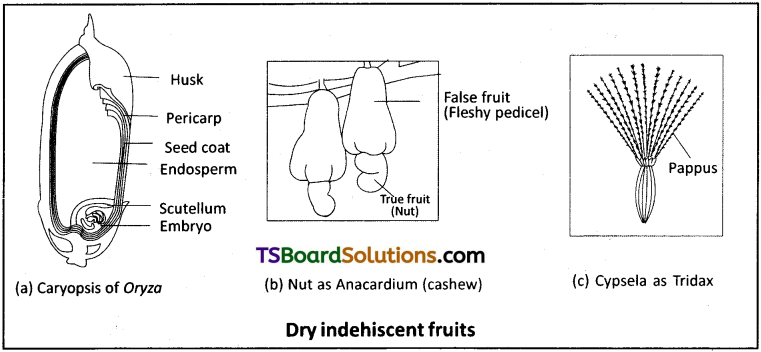
Long Answer Type Questions
Question 1.
Define root. Mention the types of root systems. Explain how root is modified [Mar. 17 A.P & T.S ; Mar. 15 – A.P & T.S ; Mar. 13]
Answer:
The part of the plant body present below the soil is called root. It is developed from radicle. There are two types of root sytems.
- Tap root system
- Fibrous root system
In some plants root is modified to perform new function suitable for the environment. It is called root modification. They are
1) Storage roots :
The roots which store food materials are called storage roots or tuberous roots. In biennial plants, the tap root is modified into storage roots. Depending upon the shape, they are
a) Spindle shape (fusiform) Eg: Radish
b) Cone shape (Conical) Eg: Carrot
c) Top shape (Napiform) Eg: Beetroot
Adventitious roots of sweet potato and fibrous roots in Asparagus store food materials.
2) Prop roots or Pillar roots :
In plants like banyan trees, branches are large and heavy.
From the branches roots arise, they hang in air for sometime and later fixes into the soil.
They are called prop roots or pillars roots.
They act like pillars and gives support.
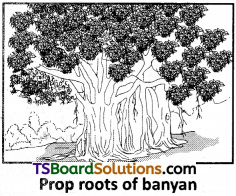
3) Stilt roots :
In plants like maize and sugarcane roofs arise from the lower nodes of the stem. They are called stilt roots. They give support to plant.
4) Pneumatophores or Respiratory roots :
The Mangrove plants which grow in swampy areas suffer from lack of oxygen as the soils are water lodged. In these plants root comes out of soil and grow vertically upwards. These roots are called respiratory roots or pneumatophores as they take oxygen from air for respiration.
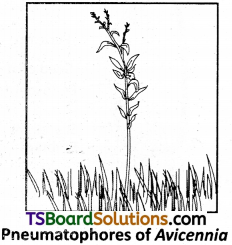
5) Photosynthetic roots :
In Taeniophyllum (epiphyte) the stem and leaves are absent. The roots become green and perform photosynethsis. Such roots are called photosynthetic roots.
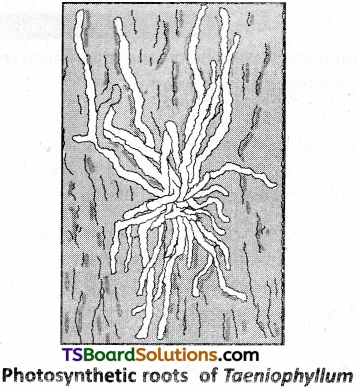
6) Velamen roots or Epiphytic roots :
The plants which grow on the branches of big trees for sunlight are
called epiphytes. They have roots which hang freely
in the air. They absorb moisture from the atmosphere. These roots are called velamen roots
or epiphytic roots. Eg : Vanda.
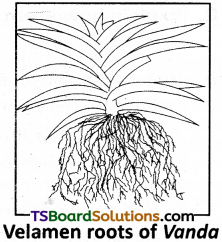
7) Nodular roots :
In members of Fabaceae, the roots show small nodule like structures. Hence it is called nodular roots. In the nodule, Rhizobium bacteria is present. It fixes atmospheric nitrogen into soil. Plant and Rhizobium show symbiotic association.
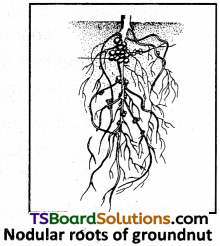
8) Parasitic roots or Kaustoria :
The plants which depend upon the other plants completely or incompletely for their food and water are called Parasites. They produce parastic roots. They are 1) Complete parasites 2) Partial parasites.
a) Complete parasitic piamts :
These are leafless. So the haustorial root enters into both xylem and phloem to obtain both water and food from the host plant. Ex : Cuscuta, Rafflesia.
b) Partial parasitic plants :
These plants bear leaves. So they can prepare food by photosynthesis. The haustorial roots penetrate only into the xylem tissue of the host to absorb water.
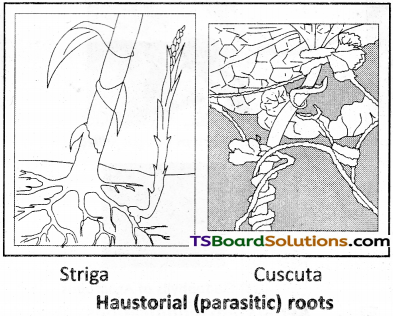
![]()
Question 2.
Explain how stem is modified variously to perform different functions. [Mar. 2020, 2019, 14, May 2017 ’14]
Answer:
When a permanent change occurs in the structure of stems to perform new functions suitable for the environment, it is called ‘stem modification’.
It is of three types. They are
I. Aerial stem modification
II. Sub aerial stem modification
III. Underground stem modification
I. Aerial stem modification :
Modification of aerial stems, vegetative buds and reproductive buds of a plant is called aerial stem modification.
a) Tendril :
Wiry delicate organ useful for climbing are called tendril. Axillary bud modified into tendril in gourds (cucumber, pumpkin, watermelon) or terminal bud in grapevines.
b) Thorn :
A woody pointed structure meant for protection are called thorns. Axillary bud modified into thorn. Eg : Bougainvillea. Terminal bud modified into thorn. Eg : Carissa.
c) Hook :
It is a woody, curved structure which helps in climbing. Ex : Artabotry.
d) Phylloclade :
Leaf like stem performing photosynthesis are called phylloclade. In order to reduce transpiration the leaves are modified into scales, spines etc.
Ex : In Opuntia, fleshy green flattened stem
In Euphorbia, fleshy green cylindrical stem In Casuarina green needle like stem.
Cladode or Cladophyll is a phylloclade of limited growth. Ex : Asparagus.
e) Bulbils :
Buds which show vegetative propagation are called bulbils. Vegetative buds in Dioscorea, Floral buds in Agave.
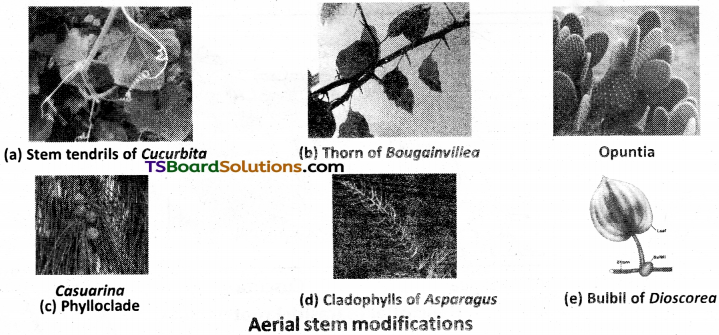
II. Sub aerial stem modification :
In some weak stemmed plants the stem remains partly aerial and partly underground. These are specialised for vegetative propagation. There are four types.
a) Runner:
Underground stems in some grasses and strawberry and sub-aerial stems in oxalis spread to new nitches and form new plants when older parts die.
b) Stolon :
In some plants slender branches arises grow obliquely downwards, produce roots at the point of contact with soil. These branches are called stolons. Ex : Nerium, Jasmine etc.
c) Suckers :
In plants like banana, pine apple, chrysanthemum part of the stem is in the soil. Underground branches grow obliquely upwards giving rise to leafy shoots. These branches are called suckers.
d) Offset :
In aquatic plants like Pistia and Eichhornia, a lateral branch of one internode length is called offset. At each node it bears a rosette of leaves and balancing roots at the base.
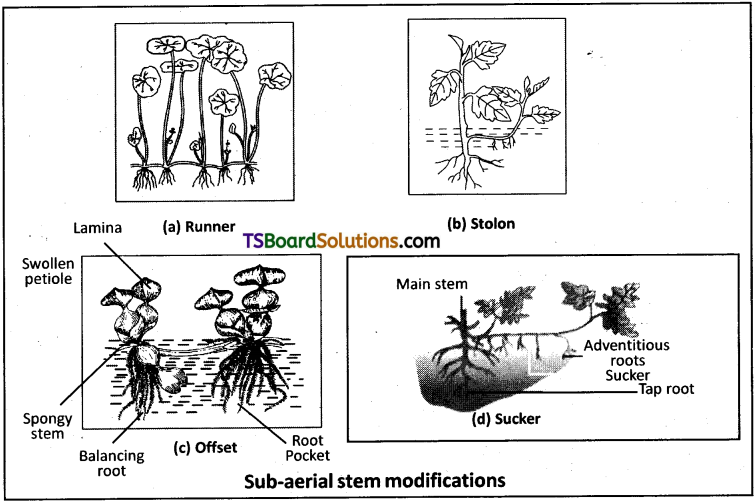
III. Underground stem modification :
Functions of the underground stems are storage of food materials, perennation through unfavourable seasons and vegetative reproduction. So these are called multipurpose stem modification.
a) Rhizome :
It is an underground stem which grows horizontally. It is branched. Ex: Zingiber (ginger).
b) Corm :
It is an underground stem which grows vertically. It is unbranched contractile roots present. Ex : Amorphaphallus (Zaminkand) and colocasia.
c) Stem tuber :
The swollen tip of an underground branch is called stem tuber. It bears many eyes. These eyes represent the nodes. Ex ; Potato.
d) Bulb :
It is a small reduced underground stem. Food is stored in the leaf bases. Ex: Onion.
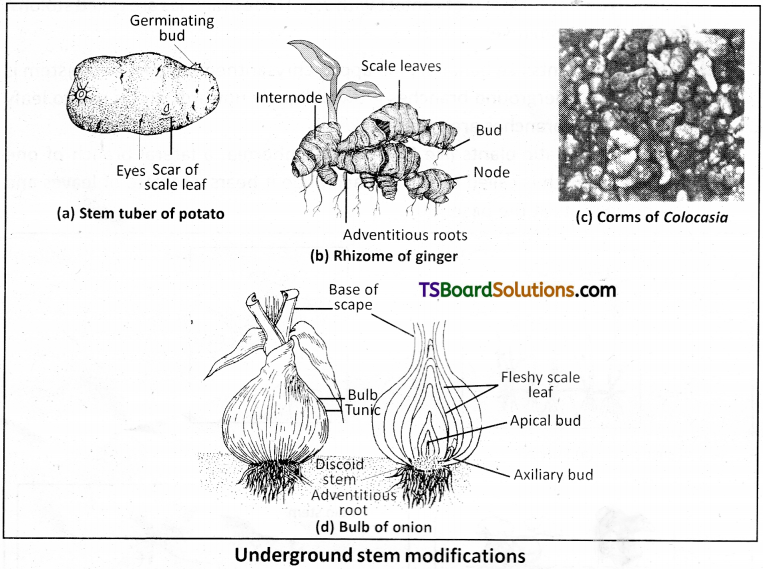
Question 3.
Explain different types of racemose inflorescences.
Answer:
Types of racemose inflorescence.
1) Simple Raceme :
Peduncle is unbranched, grows indefinitely on its numerous pedicillate, bracteate flowers are arranged in accropetal manner.
Ex: Crotalaria.
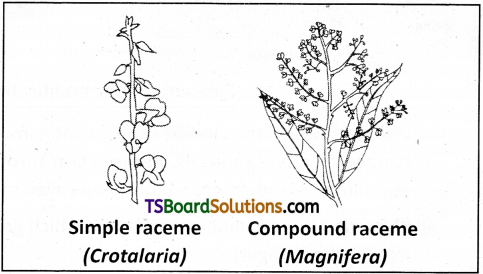
2) Compound Raceme :
Peduncle is branched. Each branch resembles a simple raceme. Ex: Mangifera. It is also called Panicle.
3) Simple Corymb :
Peduncle is unbranched and grows indefinitely. On it numerous pedicillate, bracteate flowers are arranged in accropetal manner. The lower flowers have long pedicels and upper flowers have shorter pedicels. Thus all the flowers are brought more or less to the same height. Eg: Cassia.
4) Compound Corymb :
Peduncle is branched and each branch is produced into a simple corymb. Eg: Cauliflower.
5) Simple Umbel :
The peduncle is condensed and unbranched. Many bracteate and pedicellate flowers arise at the tip. At the base of flowers, all the bracts form a whorl called ‘involucre’. Ex: Onion.
6) Compound Umbel :
Peduncle is branched. Each branch produces a simple umbel at its tip. Ex : Carrot.
7) Simple Spike :
Peduncle is unbranched. On it bracteate, sessile flowers are arranged, accropetally. Ex : Achyranthes.
8) Compound Spike :
Peduncle is branched. Each branch is similar to simple spike. Ex: Grass (Poaceae family).
9) Simple Spadix :
Peduncle is unbranched. On it sessile, unisexual and neuter flowers are arranged in acropetal succession. It is protected by modified bract called ‘Spathe’. Ex: Colocasia.
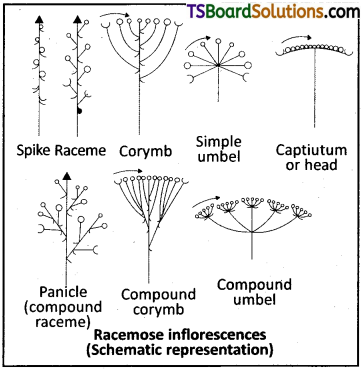
10) Compound Spadix :
Peduncle is branched. Each branch is similar to simple spadix. Ex: Musa, Cocos.
11) Head inflorescence :
Unisexual and bisexual sessile flowers are arranged centripetally on a condensed peduncle. Such an arrangement of flowers is called Head inflorescence. Ex: Tridax, Sunflower (Asteraceae family).
Intext Question Answers
Question 1.
In which plant, the underground stem grows horizontally in soil and helps in perennation?
Answer:
Zingiber (ginger)
Curcuma (turmeric)
Question 2.
Needle like phylloclades are found in which plant?
Answer:
Casuarina
![]()
Question 3.
Why do plants like Nepenthes trap insects?
Answer:
For their nitrogen requirement
Question 4.
What is the characteristic inflorescence found in members of Asteraceae?
Answer:
Head inflorescence
Question 5.
Can you name a plant that has least number of flowers in its inflorescence?
Answer:
Single flower in Hibiscus and Datura
Question 6.
Which family shows naked flowers?
Answer:
Euphorbiaceae family
Question 7.
In which flowers of the fig trees does the insect Blastophaga lay its eggs?
Answer:
Gall flowers (Sterile female flowers)
Question 8.
What type of symmetry is shown by the flowers of Canna?
Answer:
Asymmetry (irregular)
Question 9.
On which side of the flower do the flowers of pea have the keel petals?
Answer:
Anterior side
Question 10.
What is the ratio of overlapping margins of petals to overlapped ones in imbricate aestivation?
Answer:
1 : 1
Question 11.
How many ovules are found attached in basal placentation?
Answer:
One ovule
Question 12.
Which part of the flower in cashew plant forms the false fruit?
Answer:
Pedicel
Question 13.
Which plant has hard, stony endocarp and fleshy edible mesocarp?
Answer:
Mango
Question 14.
What is the morphology of ’spathe’ in Spadix inflorescence?
Answer:
Bract
![]()
Question 15.
What is the type of fruit known as if it develops from apocarpous ovary of a single flower?
Answer:
Aggregate fruit